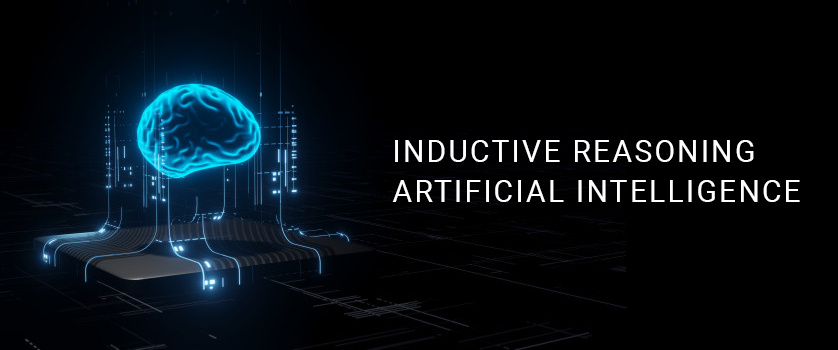
Anshul Jain
August 14 , 2020
In order to resolve an issue, we humans are highly reliant on our reasoning capabilities, as it helps us reach a valid conclusion after analyzing all the possible situations, data, and scenarios. Similarly, in artificial intelligence, machines rely on reasoning techniques that help them stimulate the human reasoning process. These techniques enable machines to think rationally and assess the excessive amount of data and information collected and stored from the surrounding environment. It is with the help of reasoning that one of the goals of Artificial Intelligence and machine learning is accomplished, i.e to stimulate human-like reasoning capabilities in machines.Today, we will be discussing one of these important reasoning techniques of artificial intelligence, Inductive Reasoning AI, with an aim to try and understand the role it plays in making intelligent machines efficient.
Only before we dive deep into inductive reasoning, let's first comprehend the importance of reasoning in AI.
Reasoning in Artificial Intelligence:
A process, as stated above, similar to the reasoning performed by humans, Reasoning in AI is used to derive logical conclusions and make predictions based on the available facts, knowledge, as well as believes. It helps machines think rationally and infer facts from the existing data to reach a valid conclusion. To perform these actions successfully, AI further makes use of the following types of reasoning techniques:
- Deductive Reasoning: Also referred to as top-down reasoning, it helps deduce new information from logically related known information.
- Inductive reasoning: It is used to arrive at a conclusion using limited sets of facts through the process of generalization.
- Abductive reasoning: This logical reasoning type starts with single or multiple observations and identifies the most suitable explanation or conclusion for an observation.
- Common Sense Reasoning: It is an informal form of reasoning that operates on heuristic knowledge and heuristic rules and that can be gained through experiences.
- Monotonic Reasoning: Used in conventional reasoning systems and logic-based systems, monotonic reasoning makes use of the available information and facts to reach a conclusion. Here conclusion remains that even with new or added information.
- Non-monotonic Reasoning: This type of reasoning deals with incomplete and uncertain models and terms conclusions invalid if new or more information is added to the knowledge base.
- Forward & Backward Reasoning: Most commonly used in expert systems, game theory, general-purpose inference engines, etc. forward and backward reasoning help machines simulate human reasoning capabilities.
To learn more about reasoning in AI, click here.
So, now that we know what reasoning is in Artificial Intelligence, we can move on to thoroughly defining inductive reasoning.
Let's begin.
Introduction to Inductive Reasoning:
The second most important reasoning in Artificial Intelligence, Inductive Reasoning is a form of propositional logic. It is a logical process, wherein numerous premises are combined to get a specific result. Also known as cause-effect and bottom-up reasoning, inductive reasoning uses limited sets of data and facts to reach a conclusion, through the process of generalization. In short, it initiates the process of reasoning with a series of specific data and then arrives at a general conclusion.
Often used in machines and applications that make predictions, forecasts, or involve behavior, inductive reasoning is not logically rigorous and can provide inaccurate conclusions, as premises only provide probable support to the final output and even though the premises are true, they do not guarantee the accuracy of the final conclusion.
In a way, inductive reasoning in AI corresponds to everyday reasoning, where our decisions are based on proving the conclusion right based on the inductive logic or the available knowledge.
Examples of Inductive Reasoning:
Inductive reasoning is mainly the reasoning performed by Sherlock Holmes, where he moves from specific observation to a general idea. Therefore, to better help you understand the concept of inductive reasoning, here is an example of the same:
Premises: All of the apples we have seen in the bag are green.
Conclusion: Therefore, we expect all the apples to be green.
Though the bag consists of multiple green apples, there can still be a possibility that red color apples are present in it. Hence, the accuracy of the premises does not guarantee the accuracy of the final conclusion (all apples are green in the bag) in inductive reasoning.
Steps to Perform Inductive Reasoning:
Inductive reasoning draws a conclusion with the help of a process, which starts with a probable conclusion and induces premises. Here, the conclusion is mostly a statement or hypothesis, which is observed for patterns and proved based on evidence. Hence, the steps to perform inductive reasoning involve:
- Observations: The first stage of the process involves observing the data or situation to identify certain similarities. For example, you observed 1000 lows cost flights that experienced a delay.
- Patterns: Here, the focus is to identify the patterns that are common in all the scenarios, like all low-cost flights are delayed.
- Hypothesis: Once a pattern is recognized, a hypothesis is made, along with the evidence to support it, which plays a major role in drawing a conclusion. For example, another 20 low-cost flights are delayed.
- Theory: Finally, a theory is established based on the observation and evidence that low-cost flights have delays.
Types of Inductive Reasoning:
Inductive reasoning is divided into three types, which though similar are different in their form and are further divided into different classifications.
- Generalization: Generalization or Inductive generalization starts from the premise of a sample and makes a conclusion about the population. It observes the patterns from the sample and projects it onto the broader population. Moreover, the support of the premises for the conclusion is based on facts like:
- Size of the sample group.
- Size of the population.
- The degree to which the sample represents the population.
Furthermore, Inductive Generalization is classified into the following categories:
- Statistical Inductive Generalization: A type of inductive argument, statistical generalization infers the conclusion about a population using a statically-representative sample. Also known as statistical projections and sample projections, this category of generalization is highly reliable.
- Anecdotal Inductive Generalization: Another type of inductive argument, here the conclusion is inferred about a population is inferred with the help of a non-statistical sample. Compared to statistical generalization, anecdotal generalization less reliable.
- Prediction: In the third category of generalization, the conclusion is drawn about a future population/individual based on a past sample.
- Analogy: Unlike inductive generalization, analogical inference notes the shared properties of two or more components, and based on the specific observations infers that they also share further properties or characteristics. This type of inductive inference is commonly witnessed in science, philosophy, common-sense, law, etc.
- Causal Inference: Causal inference is a process wherein the conditions of the occurrence of an effect is used to derive a conclusion about a causal connection.
Methods for Inductive Reasoning:
To reach a conclusion using the inductive approach, inductive reasoning uses two principal methods:
- Enumerative Induction: Also referred to as simple induction or simple predictive induction, enumerative induction reaches the conclusion based on the number of instances that support it. The higher the number of supporting instances, the stronger is the conclusion. This is the most common method of induction and a subcategory of inductive generalization.
- Eliminative Induction: Unlike enumerative induction, eliminative induction, or variative induction, reaches the conclusion based on the variety of instances that support it. Its reasoning process relies on the different kinds of instances that support a conclusion, rather than the number of instances that support it. The importance of this induction is immense in science, as it helps eliminate hypotheses that are inconsistent with observations and experiments.
Now that we understand the need for as well as the importance of inductive reasoning in artificial intelligence, let's move on to the next important question, What is the difference between deductive and inductive reasoning?
To know the answer, read on...
Difference Between Inductive Reasoning and Deductive Reasoning:
While defining inductive reasoning it is imperative to mention deductive reasoning, as they two are a basic form of propositional logic and common techniques used for reasoning in Artificial Intelligence, Machine Learning, and more. However, the similarities between inductive and deductive reasoning end here, as they follow contrasting processes and reach the conclusion with different levels of accuracy.
Therefore, here are some important deductive and inductive arguments that differentiate these two reasoning techniques from one another:
Inductive Reasoning
- Makes a generalization from specific facts and observations.
- In inductive reasoning, the argument's premises can never guarantee that the conclusion must be true.
- As it requires only evidence, its reasoning process is fast and easy.
- Here the process moves from specific to general.
- Also known as cause-effect or bottom-up reasoning.
Deductive Reasoning
- Reaches a valid conclusion using available facts and knowledge.
- In deductive reasoning, an argument is valid when, assuming the premises are true, the conclusion must be true.
- As it requires true facts, its process is difficult in comparison to inductive's.
- Whereas, here the process moves from general to specific.
- Also known as top-down reasoning.
Conclusion:
With the complexities and difficulties in the field of computer science, artificial intelligence, and mathematics increasing day-by-day, the need for machines that are capable of performing reasoning like humans is increasing tremendously. AI experts worldwide are leveraging these reasoning techniques and their capabilities to inculcate robots and machines with remarkable reasoning abilities that will allow them to solve complex problems and reach the most suitable solution and conclusion using their full potential.
Hence, there is no wonder that in the upcoming years, these reasoning techniques, along with other advanced technologies will give way to a technology that could effortlessly outperform the reasoning performed by the human brain.




